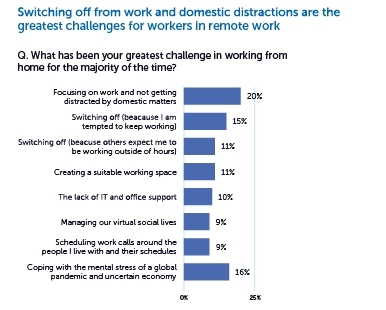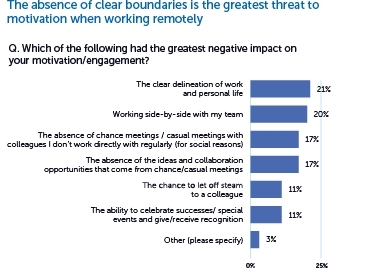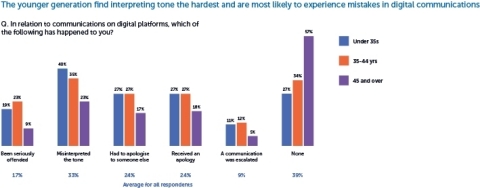LONDON--(BUSINESS WIRE)--A new study by digital transformation leaders, Adaptavist, highlights the threats to long-term productivity and employee well-being posed by improvised solutions during the transition to remote work. Overall, 82% of people report they are equally (47%) if not more productive (35%) working from home, and company-wide communications have improved during the pandemic. However, the lack of a shared understanding of which tool to use and how to communicate with it, combined with the ‘always on’ nature of working from home, brings added stress and motivational challenges for workers.
The Adaptavist Digital Etiquette Study, which includes survey responses from 2,800 knowledge workers across the UK, USA, Canada and Australia, shows remote working offers major benefits for businesses, but new digital communication and productivity challenges have also emerged.
The study found significant benefits to 100% remote working approach
‘Levelling the playing field between in-office and remote workers’ and ‘working in a more agile fashion with faster decision-making’ were seen as key benefits from the transition. Other notable benefits include:
- ‘Learning we can be more flexible in how we work’ ranked as the top benefit.
- 52% agreed that company-wide communication had improved (39% neutral and 9% disagreed).
- 48% agreed that collaboration had improved (41% neutral and 11% disagreed).
- The reduction in office politics thanks to the removal of the office was also seen as a key benefit
- 46% agreed that meeting effectiveness had improved. (42% neutral and 12% disagreed).
Simon Haighton-Williams, CEO of Adaptavist explains: “In many organisations surveyed their culture and use of tools meant that those who were not in the same physical location as the people they were working with, were less able to fully input and collaborate. There was an imbalance or divide in the way they communicated. The ‘accidental’ benefit of everyone being remote is that communication, collaboration and decision making can be the same experience for everyone. This effect is something organisations should cherish and preserve if, and when, they return to the office."
‘Always on’ threatens motivation and increases burnout risk
The absence of boundaries between our work and personal lives was the highest ranked threat to motivation for employees, with 21% citing this as having the most significant negative impact on motivation.
- The ‘always-on nature’ of digital communications (42%) and the ‘number of channels I have to check’ (31%) were seen as the greatest sources of stress and frustration in work-related communications.
- 20% of respondents were distracted from work by domestic affairs.
- For 26% switching off from work was the greatest challenge. Temptations to keep working (cited by 15%) seem to be a bigger problem than pressure from others (11%).
- 60% of respondents don’t switch off notifications after work.
- Parents fared better than non-parents in switching off, with only 24% struggling to switch off vs. 29% of non-parents. External pressures to continue working were equal, but parents were less tempted to keep working.
- 43% had always used the same platforms for work and personal communications, but an additional 31% have started due to the COVID-19 pandemic.
- One in three workers (33%) is now using WhatsApp for work.
Inefficient use of digital channels means businesses lose almost half a work day each week per employee
- The top 5 greatest challenges in running remote teams were: technical issues; managing workloads; tracking what people were working on and the status of work; keeping teams motivated; and knowing how people are feeling.
- Even with the availability of new communication tools, the vast majority are still using email (71%) and spreadsheets (62%) to track work.
- On average, workers spent 45 minutes a day searching for information between different technology platforms. This increased to 50 minutes a day – almost half a day each week — for those using four platforms or more (42%)
- Less than half of workers had been given any training to ensure they are using these channels efficiently.
“High-performing teams embody mastery, autonomy and purpose, so it’s natural that people adopt the tools that have proven to work well in their personal lives when faced with new challenges in their professional lives. However, organising the chaos and confusion between these channels is key to maximising the benefits they bring,” says Simon Haighton-Williams, CEO of Adaptavist.
Lack of consensus on digital etiquette increases anxiety
Without clear guidelines or set expectations, workers struggle to come to consensus on what and how to communicate with their colleagues:
- 38% of survey respondents admitted to worrying at least once a day about how they communicate on digital platforms for work and for 1 in 10 this is a constant worry.
- Younger workers are particularly afflicted by digital communication angst and more likely to have misinterpreted the tone of digital communications.
- Workers over the age of 45 are actually more confident in their use of digital channels with only 5% worrying constantly and only 22% worrying daily (vs 46% of under 35s).
“An overnight transition has been forced upon the business world and companies have had to rise to the challenge by doing whatever seems to work immediately. Now, it’s time to reflect and analyse this, to see what positive patterns have arisen that we need to reinforce and what negative patterns we see, that need to be changed. Those that get this right will innovate faster, be more operationally efficient and attract top talent. Those that don’t will likely struggle to survive,” notes Simon Haighton-Williams.
For further insights and to download the report visit https://adaptavist.com/remotework
ENDS
Notes to editors
Additional data
- 43% of respondents had always used the same platforms for work and personal communications, but an additional 31% have started to do so due to the COVID-19 pandemic.
- An equal proportion of parents and non-parents found they were less productive working from home (18%), but a greater share of parents felt more productive (38% vs. 31% of non parents). The remainder (52% of non parents and 44% of parents) felt equally productive.
- The proportion of workers using four or more platforms for work was also higher amongst those under 45 at 47%, whereas just 32% of over 45s use four or more platforms. Just 22% of over 45s are using WhatsApp for work vs. 38% of under 45s.
- The study highlights a distinct lack of consensus in what is acceptable conduct on digital platforms with an equal share believing it is always acceptable for children to appear on a video conference as those who feel this is never acceptable.
- 19% felt it is never acceptable for children to appear, but only 16% felt pets should be kept out of video conferences.
- 40% of under 35-year-old respondents had misinterpreted the tone of communication on a digital platform vs. just 23% of the over 45-year-olds.
About the Adaptavist Digital Etiquette study
Over 2,800 workers from a mix of office-based industry sectors and departments across the USA (c. 1000), UK (c. 1000), Canada (c. 400) and Australia (c. 400) were surveyed for Adaptavist’s Digital Etiquette study. The research was conducted in May 2020 by Propeller Insights. The age breakdown was: 13% of respondents were 18-24 years old; 27% 25-34; 26% between 35-44; 20%, 45-54; 11% 55-64; and 3% over 65 years old.
About Adaptavist
Adaptavist is a global technology and innovative solutions provider, enabling organizations to boost agility and overcome the challenges of transformational change. Founded in 2005, its team spans over 300 employees globally, with a 13,000+ customer base representing more than half of the Fortune 500.
Adaptavist is a Platinum Atlassian Solutions Partner in EMEA and North America, a Platinum Marketplace Partner, and a trusted Slack partner. It offers expert consultancy including SPC-certified SAFe® implementation, enterprise apps, training, managed services, and licensing solutions. Adaptavist has also been the recipient of the Queen’s Awards for Enterprise, Deloitte’s Technology Fast 50, and The Sunday Times Tech Track Award 2019.






